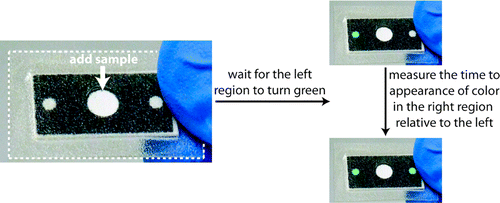Paper-based device could bring medical testing to remote locales

In remote regions of the world where electricity is hard to come by and scientific instruments are even scarcer, conducting medical tests at a doctor's office or medical lab is rarely an option. Scientists are now reporting progress toward an inexpensive point-of-care, paper-based device to fill that void with no electronics required. Their study on the extremely sensitive test, which simply relies on the user keeping track of time, appears in the ACS journal Analytical Chemistry.
Scott T. Phillips and colleagues point out that people living in places with limited resources often don't have the means to purchase and operate conventional medical tests. Such tests, conducted at a doctor's office or clinical laboratory, detect or monitor disease with a hand-held or desktop electronic device. Many of them work by measuring the levels of specific proteins in a patient's blood that can indicate a wide range of serious medical conditions, including heart attacks and certain cancers. Phillips' team wanted to develop a similar and sensitive tool to measure small amounts of disease markers that would be much less expensive, easier to operate and work without a power source.
They developed a new paper-based device that is about the size of a stick of gum. In initial experiments, they used it to detect a liver enzyme that in high amounts can suggest liver or bone problems, and another enzyme that is a marker for fecal contamination in water. After applying a sample to the device, a small white dot turns green if the enzyme is present. After a few seconds or minutes, another small white dot turns green. The longer it takes for the second dot to change color after the first, the higher the concentration of the enzyme. The device uses just a few inexpensive materials and can be altered to measure a wide range of enzymes to monitor many different conditions.
More information: "Point-of-Care Assay Platform for Quantifying Active Enzymes to Femtomolar Levels Using Measurements of Time as the Readout" Anal. Chem., Article ASAP. DOI: 10.1021/ac402415v
Abstract
This Article describes a strategy for quantifying active enzyme analytes in a paper-based device by measuring the time for a reference region in the paper to turn green relative to an assay region. The assay requires a single step by the user, yet accounts for variations in sample volume, assay temperature, humidity, and contaminants in a sample that would otherwise prevent a quantitative measurement. The assay is capable of measuring enzymes in the low to mid femtomolar range with measurement times that range from 30 s to 15 min (lower measurement times correspond to lower quantities of the analyte). Different targets can be selected in the assay by changing a small molecule reagent within the paper-based device, and the sensitivity and dynamic range of the assays can be tuned easily by changing the composition and quantity of a signal amplification reagent or by modifying the configuration of the paper-based microfluidic device. By tuning these parameters, limits-of-detection for assays can be adjusted over an analyte concentration range of low femtomolar to low nanomolar, with dynamic ranges for the assays of at least 1 order of magnitude. Furthermore, the assay strategy is compatible with complex fluids such as serum.
Journal information: Analytical Chemistry
Provided by American Chemical Society





















